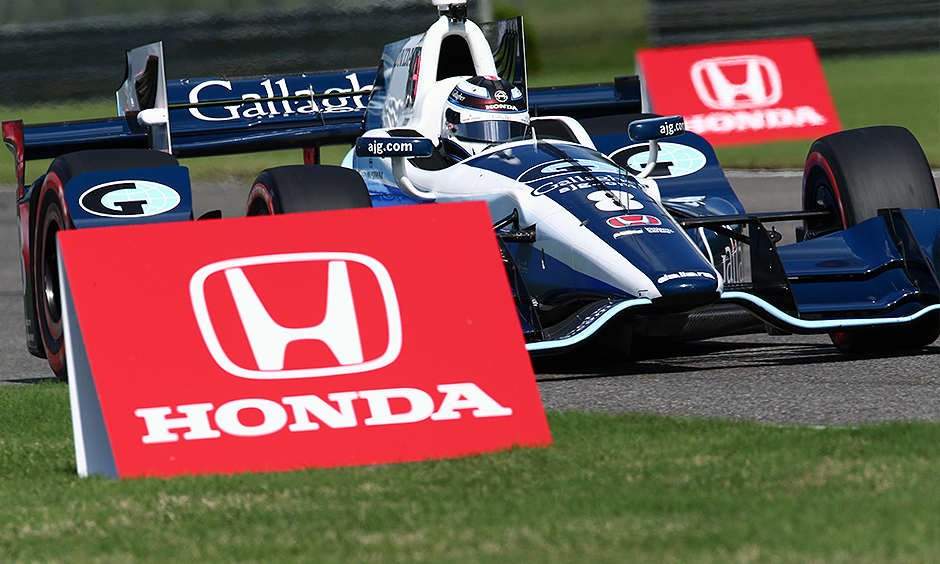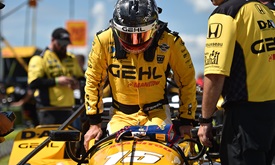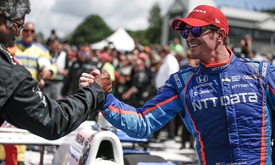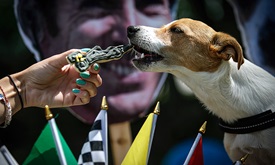Honda finds fix for what was plaguing its INDYCAR engines
JUN 30, 2017
Scott Dixon’s win June 25 in the KOHLER Grand Prix gave Honda its sixth victory in the Verizon IndyCar Series this season, in what’s shaping up to be quite the competition with manufacturer Chevrolet.
After 10 of 17 races, Honda holds a 46-point advantage over Chevrolet in the manufacturers’ championship. Manufacturers earn the equivalent of driver points for their top two finishers in each race, plus a five-point bonus for winning a race and one point for winning the pole position (two points for the Indianapolis 500).
Honda’s success has come despite what its representatives admit are several engine failures this season as it pushes the limits to vie for its first manufacturers’ championship since Verizon IndyCar Series engine competition resumed with Chevy’s 2012 return.
During the KOHLER Grand Prix weekend at Road America, Art St. Cyr, the president of Honda Performance Development, said his group pinpointed the cause of the failures to an internal part that has been used for three years and not shown susceptibility until this season. A fix has been made, St. Cyr added, and will be implemented as Honda builds new engines to move into its rotation with teams for the remainder of the season.
Depending on where a car’s current engine mileage stands, some new powerplants will be installed in Honda cars in time for next week’s Iowa Corn 300 at Iowa Speedway. St. Cyr expects the bulk of the 13 fulltime cars that Honda supplies to have the updated engine in time for the Honda Indy Toronto weekend July 14-16.
“There is no plan right now to do a wholesale change of our engines,” St. Cyr said. “Right now, it looks like (the failure) happens in about one out of every eight engines that we have right now. If it does fail, it usually fails early, so when that problem arises, it shows up pretty quick.
“Our expectations are that once we get the engines in the spares pool, we will continue (using) the engines that are in the car throughout the remainder of their (mileage) lives. Then those will be replaced with new engines.”
St. Cyr did not identify the part in question, but said it had not shown reliability issues in past years. He called it “an intermittent processing issue that wouldn't show up in a simulation, (and that) resulted from a (microscopic component fault) in our engine that was obviously not designed in.”
While the part was not previously part of Honda’s quality control process, St. Cyr added, “I can emphatically say they now are part of the checks.
“It's not saying we won't have more failures, but we won't have that failure anymore.”
Pushing the limits of technology is part of the allure of Verizon IndyCar Series manufacturer competition, St. Cyr said. Both engine manufacturers have also produced aerodynamic bodywork kits for their teams since 2015, with Chevrolet displaying an aero kit advantage on many tracks that helped it win 14 of 16 races and its fifth straight manufacturers’ championship last year.
With aero kit development frozen this year as INDYCAR prepares to provide all entries with a universal aero kit supplied by Dallara in 2018, Honda focused on making engine gains to take the battle to Chevrolet. Anytime an engine is asked to deliver more power, however, the risk of failure increases.
“When you make more horsepower, you do expose parts to more stresses,” St. Cyr explained. “That's the fundamental thing about it. In this particular case, what it did is it reduced our safety factor on that particular part.”
For their part, Honda’s customers haven’t faulted the manufacturer for the failures. If anything, said Andretti Autosport CEO Michael Andretti, the teams shoulder responsibility.
“I don't blame Honda at all,” Andretti said after his driver, Takuma Sato, won the 101st Indianapolis 500 but two other team drivers – Ryan Hunter-Reay and Fernando Alonso – suffered engine malfunctions while running near the front. “I think, if anything, I blame all of us pushing Honda so hard.
“They had come to us and said, ‘We can give you a little less reliable engine, but it will have more power.’ We all, of course, said, ‘Let's go for the power.’ When we did that, obviously you know there's going to be some sad faces. That's what happened.”
The Indianapolis 500 is the cherished motorsports prize for drivers, teams and manufacturers alike. St. Cyr said Honda must annually balance the need for additional horsepower on the iconic Indianapolis Motor Speedway oval with the necessity for reliability. It’s a never-ending “power” struggle.
“In general, our main goal is to win the Indy 500,” St. Cyr said. “We knew that even if we ran the engines at full power, the majority of our engines were going to make it. In that case, we were willing to make that tradeoff. If it was going to fail every engine, then maybe not.
“Every circumstance is different, but in this case, we were willing to make that call. You're at risk every year.”
Graham Rahal, driver of the No. 15 Rahal Letterman Lanigan Racing Honda, has been one of the engine maker’s most vocal supporters. The winner of both races in, ironically, the Chevrolet Detroit Grand Prix presented by Lear earlier this month, Rahal expressed his support again during the Road America weekend.
“Honda has done a hell of a job on the engine,” Rahal said. “I love their mentality. Obviously, there's been some issues here in recent times. They flat-out said, ‘We're here to race to win.’
“Typically, I'd say Honda is a fairly conservative company in many ways. To see them in complete attack mode here on the racing side is awesome.”
Practice and qualifying for the Iowa Corn 300 take place Saturday, July 8 at Iowa Speedway, with NBCSN carrying single-car qualifying live at 3 p.m. ET. Live race coverage starts at 5 p.m. Sunday, July 9 on NBCSN and the Advance Auto Parts INDYCAR Radio Network.
For more information about Honda Racing, visit http://hpd.honda.com/.




















